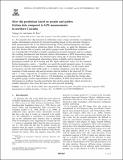Slow Slip Predictions Based on Granit and Gabbro Friction Data Compared to GPS Measurements in Northern Cascadia
Published Version
https://doi.org/10.1029/2008JB006142Metadata
Show full item recordCitation
Liu, Yajing and James R. Rice. Slow slip predictions based on granite and gabbro friction data compared to GPS measurements in northern Cascadia. Journal of Geophysical Research 114:B09407.Abstract
For episodic slow slip transients in subduction zones, a large uncertainty in comparing surface deformations predicted by forward modeling based on rate and state friction to GPS measurements lies in our limited knowledge of the frictional properties and fluid pore pressure along shallow subduction faults. In this study, we apply the laboratory rate and state friction data of granite and gabbro gouges under hydrothermal conditions to a Cascadia-like 2-D model to produce spontaneous aseismic transients, and we compare the resulting intertransient and transient surface deformations to GPS observations along the northern Cascadia margin. An inferred region along dip of elevated fluid pressure is constrained by seismological observations where available and by thermal and petrological models for the Cascadia and SW Japan subduction zones. For the assumed friction parameters a and a − b profiles, we search the model parameter space, by varying the level of effective normal stress , characteristic slip distance L in the source areas of transients, and the fault width under , to identify simulation cases that produce transients of total aseismic slip and recurrence interval similar to the observed 20–30 mm and 1–2 years, respectively, in northern Cascadia. Using a simple planar fault geometry and extrapolating the 2-D fault slip to a 3-D distribution, we find that the friction data for gabbro gouge, a better representation of the seafloor, fit GPS observations of transient deformation in northern Cascadia much better than do the granite data, which, for lack of a suitable alternative, have been the basis for most previous modeling.Terms of Use
This article is made available under the terms and conditions applicable to Other Posted Material, as set forth at http://nrs.harvard.edu/urn-3:HUL.InstRepos:dash.current.terms-of-use#LAACitable link to this page
http://nrs.harvard.edu/urn-3:HUL.InstRepos:5104759
Collections
- FAS Scholarly Articles [18262]
Contact administrator regarding this item (to report mistakes or request changes)



